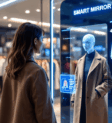Using AR and chatbots to increase customer engagement

Customers seek personalization while shopping for products. With most of the purchasing happening online, businesses are turning to advanced technologies to facilitate more interactive and engaging buying experiences for their customers.
An upcoming trend is the use of augmented reality (AR) in customer-facing chatbots. Since customers today have grown habitual to communicating with chatbots for queries and product purchases, adding AR to the spectrum opens a whole new world of immersive shopping experiences.
Estée Lauder’s Lip Artist chatbot allows you to upload a photo or click a selfie to try on lipstick shades and immediately see the results. Moreover, the bot acts as a personalized beauty consultant – suggests shades based on your skin type, asks questions about your color preferences and the occasions you are planning to wear the lipstick, and makes recommendations or gives surprise suggestions.
Based on what you like, you can click on “Shop Now” to purchase the lipstick from Estée’s website.
The Lip Artist is one among many examples of how AR is increasing customer engagement in customer-facing bots. So, let’s understand what AR is.
What is Augmented Reality (AR)?
As defined by Gartner, Augmented reality is the real-time use of information in the form of text, graphics, audio, and other enhancements integrated with real-world objects.
In other words, augmented reality is a live view of the physical, real-world environment.
Research shows, 10X marketers that employ AR see a 10x increase in engagement time, increasing retention and effectiveness. As such, 7 out of 10 media planners want to use AR to boost advertising and customer engagement.
When combined with chatbots, augmented reality allows brands the unlimited opportunity to interact three-dimensionally with customers and transform the entire customer journey into a personalized, interactive, and immersive experience.
Let’s look at some real-life examples and success stories of companies, which used AR to boost customer engagement in chatbots.
#1 POND’S
Skincare brand POND’S launched an AI-enabled skin-diagnostic chatbot called SAL, available in Indonesia via messaging app, LINE and Argentina, Columbia, UAE, and South Africa via Facebook Messenger.
SAL leverages a combination of advanced AI, AR, and skin diagnostic technologies to help consumers solve skincare problems across four significant areas – uneven skin tone, spots, pimples, and wrinkles.
Recognizing how confusing it can be for customers to pick the right skincare products, SAL provides them a more in-depth insight into their skin type and recommends the most effective products. Customers need to upload a selfie and complete a short quiz on SAL to receive a personalized skin diagnosis and product recommendations within a minute.
#2 Sephora
Beauty brand Sephora’s chatbot for Messenger helps customers make purchasing decisions on their own with its new offering, “Sephora Color Match.”
In partnership with a company that allows consumers to pick out and match colors using augmented reality, Sephora Color Match gives users the facility to hold up their camera to any face or image. Subsequently, the algorithm automatically detects and presents the identified lip color and other matching products from Sephora’s makeup line.
Additionally, customers can hold up their phones to ads and Instagram photos of personalities they admire, and the chatbot will assist them in finding suitable products to recreate the look. However, the feature is not just limited to faces. If users are looking
for matching palettes and products to complement a dress, they may hold up their camera to the outfit to locate the right products.
#3 Madison Reed
Madison Reed, a company that produces hair colors for an at-home hair treatment, talks to its customers via its Facebook Messenger chatbot, Madi. For customers, it’s like having a professional personal hair colorist right at their fingertips.
Customers need to upload a selfie, and using image recognition and hair localization, Madi identifies the primary hair color and secondary hair tones. She then asks questions about the desired outcome and suggests the perfect hair color, which can be purchased at Madison-Reed.com.
#4 IKEA
With IKEA’s Place app, customers can get a dynamic and immersive experience while shopping for furniture, keeping them engaged and convincing them about the utility of the purchase.
A chatbot built into the app assists customers in navigating the technology. The bot helps them point the camera at their surroundings, wherever they want to place the item in their living space. Customers can adjust the piece of furniture according to where they want to put it and test the shape, size, and functionality before purchasing it. In the AR environment created, they can walk around to look at the item from various angles.
Moreover, the bot comes up with suggestions and asks questions to guide the customer during the process.
The benefits of integrating augmented reality and chatbots
1. Unique selling point
A brand leveraging augmented reality in its chatbot stands out from the competition because it offers something no one else does. In such a case, a mere word of mouth is enough to make the brand “the talk of the town” and attract customers.
2. Increase engagement with personalized experiences
By showing customers how a particular product looks on them, augmented reality adds a touch of personalization to the shopping experience. Retailers can showcase their items more effectively, and the client can see the products more clearly and realistically. This leads to customized and immersive shopping experiences for customers and higher engagement rates for companies.
3. Higher revenue
Customers want to make informed purchase decisions. Chatbots that run on artificial intelligence understand customer needs better. Combine it with AR, and the customer has a memorable experience in shuffling through the various suggestions, trying out the different items, and selecting the right products. Since the customer’s decision is informative and smooth, the possibility of return orders declines, leading to increased revenues.
Final Thoughts
As seen above, using augmented reality in chatbots is the way to go for any industry where buyers require visual inspection and a look-test of the product.
The AR-chatbot customer experience model allows users to take a closer look at a new range of shoes, try out a lipstick or eyeshadow, check how a dress looks on them, and get tailored product recommendations before the actual purchase, all of this while sitting in the comfort of their homes.
Such unique and immersive experiences go a long way in generating buzz around the brand and increasing customer engagement.
To know more about AR in Chatbots, please feel free to schedule a personalized consultation with our experts.
Abhishek is the AI & Automation Practice Head at Acuvate and brings with him 17+ years of strong expertise across the Microsoft stack. He has consulted with clients globally to provide solutions on technologies such as Cognitive Services, Azure, RPA, SharePoint & Office 365. He has worked with clients across multiple industry domains including Retail & FMCG, Government, BFSI, Manufacturing and Telecom.







Abhishek Shanbhag